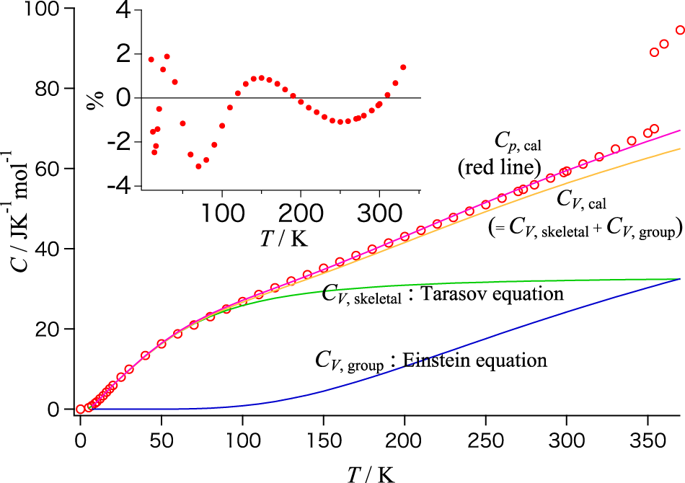Our official English website, www.x-mol.net, welcomes your
feedback! (Note: you will need to create a separate account there.)
Evaluation of the heat capacity of amorphous polymers composed of a carbon backbone below their glass transition temperature
Polymer Journal ( IF 2.3 ) Pub Date : 2020-03-05 , DOI: 10.1038/s41428-020-0317-x Marika Yokota , Kaito Sugane , Itaru Tsukushi , Mitsuhiro Shibata
Polymer Journal ( IF 2.3 ) Pub Date : 2020-03-05 , DOI: 10.1038/s41428-020-0317-x Marika Yokota , Kaito Sugane , Itaru Tsukushi , Mitsuhiro Shibata

|
Despite being a useful variable for the quantitative analysis of the thermodynamic properties of polymers, the absolute value of heat capacity remains poorly understood for amorphous polymers. This study evaluates the absolute values of the heat capacities of amorphous polymers by using the Tarasov and Einstein equations to calculate the frequencies of the skeletal and group vibration modes, respectively. Moreover, the difference between the heat capacity measured at constant pressure and that obtained at constant volume is added as a correction factor when estimating the heat capacity. The heat capacity that contributes to skeletal vibrations can be expressed using the one- and three-dimensional Tarasov equations, and the contribution of group vibrations can be determined by substituting the absorption frequency obtained from infrared absorption measurements into the frequency value of the Einstein equation. Only three fitting parameters were used to reproduce the absolute value of the heat capacity obtained from the combination of these equations. We used this approach to reproduce the heat capacities of 16 main chain-type amorphous polymers having a carbon backbone. The reproduced and experimental heat capacities of all the samples below their glass transition temperature agreed within less than ±2.5%. With the aim of gaining more insight into the heat capacity of amorphous polymers and considering that there are more than a dozen types of data on the absolute value of the heat capacity of polymer compounds, we evaluated the heat capacity of 16 main-chain-type amorphous polymers composed of a carbon backbone using a combination of the Tarasov equation, Einstein equation, and the ( C p − C V ) correction term by taking into account the degree of freedom of monomer units. We found that the heat capacity of the analyzed amorphous polymers could be reproduced using only three fitting parameters from a combination of the Tarasov and Einstein equations below glass transition temperature.
中文翻译:

评估由低于玻璃化转变温度的碳骨架组成的无定形聚合物的热容量
尽管是定量分析聚合物热力学性质的有用变量,但对无定形聚合物的热容绝对值仍然知之甚少。本研究通过分别使用 Tarasov 和 Einstein 方程计算骨架和群振动模式的频率来评估无定形聚合物的热容量的绝对值。此外,在估算热容量时,将在恒定压力下测量的热容量与在恒定体积下获得的热容量之间的差异添加为校正因子。对骨骼振动有贡献的热容量可以使用一维和三维 Tarasov 方程表示,可以通过将红外吸收测量得到的吸收频率代入爱因斯坦方程的频率值来确定群振动的贡献。仅使用三个拟合参数来重现从这些方程的组合中获得的热容量的绝对值。我们使用这种方法来重现 16 种具有碳骨架的主链型无定形聚合物的热容量。低于其玻璃化转变温度的所有样品的再现和实验热容在小于 ±2.5% 的范围内一致。为了更深入地了解无定形聚合物的热容,并考虑到高分子化合物热容绝对值的数据有十几种,我们结合塔拉索夫方程、爱因斯坦方程和 (C p − CV ) 校正项,通过考虑单体的自由度,评估了由碳骨架组成的 16 种主链型无定形聚合物的热容量单位。我们发现分析的无定形聚合物的热容量可以仅使用来自玻璃化转变温度以下的 Tarasov 和爱因斯坦方程的组合的三个拟合参数来重现。
更新日期:2020-03-05
中文翻译:

评估由低于玻璃化转变温度的碳骨架组成的无定形聚合物的热容量
尽管是定量分析聚合物热力学性质的有用变量,但对无定形聚合物的热容绝对值仍然知之甚少。本研究通过分别使用 Tarasov 和 Einstein 方程计算骨架和群振动模式的频率来评估无定形聚合物的热容量的绝对值。此外,在估算热容量时,将在恒定压力下测量的热容量与在恒定体积下获得的热容量之间的差异添加为校正因子。对骨骼振动有贡献的热容量可以使用一维和三维 Tarasov 方程表示,可以通过将红外吸收测量得到的吸收频率代入爱因斯坦方程的频率值来确定群振动的贡献。仅使用三个拟合参数来重现从这些方程的组合中获得的热容量的绝对值。我们使用这种方法来重现 16 种具有碳骨架的主链型无定形聚合物的热容量。低于其玻璃化转变温度的所有样品的再现和实验热容在小于 ±2.5% 的范围内一致。为了更深入地了解无定形聚合物的热容,并考虑到高分子化合物热容绝对值的数据有十几种,我们结合塔拉索夫方程、爱因斯坦方程和 (C p − CV ) 校正项,通过考虑单体的自由度,评估了由碳骨架组成的 16 种主链型无定形聚合物的热容量单位。我们发现分析的无定形聚合物的热容量可以仅使用来自玻璃化转变温度以下的 Tarasov 和爱因斯坦方程的组合的三个拟合参数来重现。









































 京公网安备 11010802027423号
京公网安备 11010802027423号